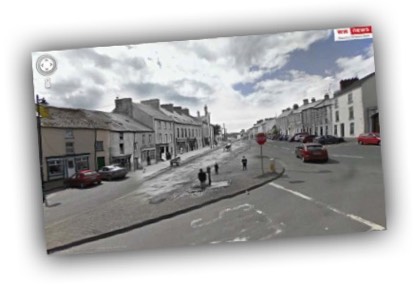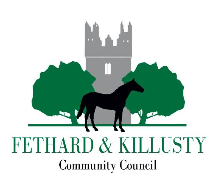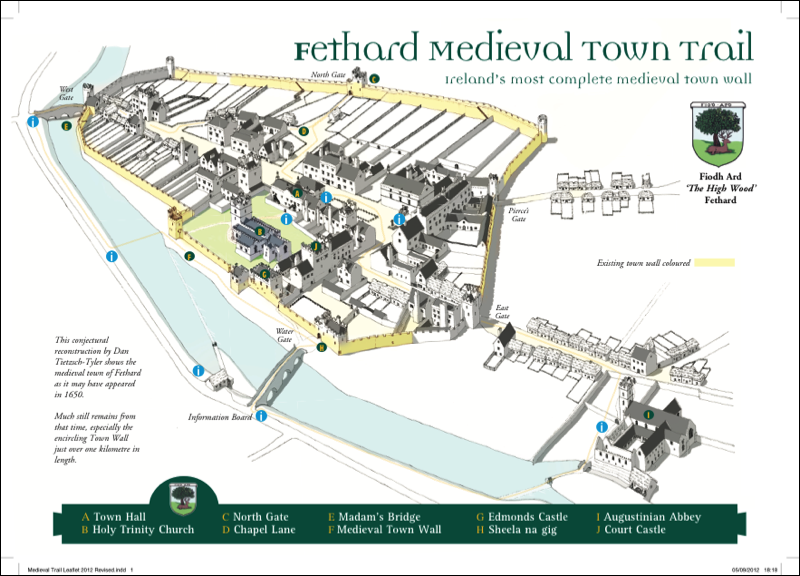Fethard Tholsel
The name Tholsel comes from two old English words
‘toll’ meaning tax and ‘sael’ meaning hall
In the early 1600's the "Fethard Tholsel" was at the time the largest almshouse in Ireland. The building's four walls survive almost to their full original height and many of its windows can be seen in the facade.
The Tholsel is one of the oldest purpose-built public buildings still existing in Ireland. It was built between 1605 and 1611 as an almshouse and bears
the coats of arms of Everard and Dunboyne.
The name Tholsel comes from two old English words
‘toll’ meaning tax and ‘sael’ meaning hall
In the early 1600's the "Fethard Tholsel" was at the time the largest almshouse in Ireland. The building's four walls survive almost to their full original height and many of its windows can be seen in the facade.
The Tholsel is one of the oldest purpose-built public buildings still existing in Ireland. It was built between 1605 and 1611 as an almshouse and bears
the coats of arms of Everard and Dunboyne.

We have refurbish and adapted the historic Tholsel building to a range of new uses and restored its historic elements.

This project has been supported by the "Adopt a Monument Scheme'"
which was an initiative of the South Tipperary Heritage Plan project and is part funded by South Tipperary County Council and The Heritage Council.
This funding has been provided by the Heritage officer since 2010
and has been a valuable contribution to our progress so far.
The partnership which has developed between Fethard Tourism & Business Group, the Heritage Council and St. Tipperary. County,Council has become a fantastic success story.
We have also received welcome funding support from South Tipperary Development Company.
which was an initiative of the South Tipperary Heritage Plan project and is part funded by South Tipperary County Council and The Heritage Council.
This funding has been provided by the Heritage officer since 2010
and has been a valuable contribution to our progress so far.
The partnership which has developed between Fethard Tourism & Business Group, the Heritage Council and St. Tipperary. County,Council has become a fantastic success story.
We have also received welcome funding support from South Tipperary Development Company.

- The Fethard Historic Town Walls Conservation and Management Plan was commissioned by South Tipperary Council Council in partnership with the Heritage Council through the Irish Walled Town Network.
- Written by Oxford Archaeology in 2009.
- This identified the Tholsel as being of “outstanding significance” from a heritage perspective. Indeed, the entire built heritage of Fethard was classified as outstanding.

The building has been owned by South Tipperary County Council since the 1930s.
The building has served as an almshouse, as the location for the Fethard Corporation, as a fire station, a library, sports hall, dance hall and a location for the Fethard Country Markets. In recent decades, the building has fallen into a state of disrepair.
The building has served as an almshouse, as the location for the Fethard Corporation, as a fire station, a library, sports hall, dance hall and a location for the Fethard Country Markets. In recent decades, the building has fallen into a state of disrepair.
Our vision;
Is that the restored Fethard "Tholsel" will become a focal point in Ireland’s premier Walled Town. It will offer a welcoming and hospitable environment where visitors and local people can relax and learn more about Fethard past and present.
Is that the restored Fethard "Tholsel" will become a focal point in Ireland’s premier Walled Town. It will offer a welcoming and hospitable environment where visitors and local people can relax and learn more about Fethard past and present.

Fethard Judo Club had their home in the Hall for many years until it disbanded.
This video details phase one renovation works at Fethard Town Hall "Fethard Tholsel" which has now been completed . Funding for Phase two has now been announced, Phase two funding will enable us the fit the lift and complete the renovations at upper floor level. This will enable us to progress our museum concept plan.

‘New ideas in Ancient Spaces’ Capital Grants Scheme is being awarded to:
Tholsel Visitor Centre, Fethard, County Tipperary (€198k) Fáilte Ireland CEO Shaun Quinn emphasised:
“Fáilte Ireland is working directly with businesses and communities on the ground to bring this new experience brand alive.
During the assessment phase for this capital funding, we were incredibly impressed by the enthusiasm and high quality of ideas within the proposals that we received.
“As an initiative firmly rooted in our past and our stories, it is vital that we bring these stories alive to take full advantage of the opportunities provided by Ireland’s Ancient East.
Tholsel Visitor Centre, Fethard, County Tipperary (€198k) Fáilte Ireland CEO Shaun Quinn emphasised:
“Fáilte Ireland is working directly with businesses and communities on the ground to bring this new experience brand alive.
During the assessment phase for this capital funding, we were incredibly impressed by the enthusiasm and high quality of ideas within the proposals that we received.
“As an initiative firmly rooted in our past and our stories, it is vital that we bring these stories alive to take full advantage of the opportunities provided by Ireland’s Ancient East.
Restoration of a Fethard ‘gem’ will create a unique tourism attraction
The town of Fethard is mounting an impressive bid to become an integral part of a new national tourist trail capitalising on its unique medieval and ecclesiastical heritage. The beautifully restored Tholsel in the town centre has had many purposes over the centuries - an alms house, fire station, courthouse, library, country market, school classrooms, corporation building and sports hall to name but a few since it was built in 1604. It is now being transformed to accommodate an ambitious project that is designed to secure a vital role in a new Ireland’s Ancient East tourism initiative receiving significant backing from the government.
The three-storey building is in the process of being turned into a spectacular tourism gem that will involve state of the art technology to bring to life the story of Fethard’s medieval and ecclesiastical heritage. Visitors will experience a wonderful journey over three floors of the Tholsel building taking them from the twelfth century to the present day in a unique experience. The Tholsel, an historic landmark in the town centre, has been tastefully restored to showcase the wonderful character of the building. Striking views - of the wonderful panorama that contains Fethard’s medieval wall, the Holy Trinity Church built in 1489, Slievenamon and the surrounding countryside from windows throughout the three floors and from a second floor terrace - greatly enhance the visit.
The new interpretative centre will be the main attraction in the building which will also accommodate a tourist/information hub, exhibition spaces and a high end retail outlet. It will also feature a history of the horse in Fethard from medieval times to the present day of the world renowned Coolmore Stud. Horses left for Cheltenham and Aintree long before the arrival of Coolmore and horses were trained in Grove before they left for the First World War and this history of the horse in the town will be illustrated by the most modern technology.
It is hoped that the first visitors will walk through the centre in late 2016/2017 and that Fethard, with the town equipped with such a unique attraction, will link in with the heritage trail taking in Cashel, Cahir and Kilkenny.
“We will have a product that will be of a very high quality, it will be state of the art, a very different tourism experience that will act as a catalyst in creating more business for the town and put on display the incredible history of Fethard in a beautiful setting,” said Maurice Moloney, a member of the Fethard Business and Tourism committee that took on the project. The committee embarked on the project in 2010, identifying a purpose for the historic but derelict building that was central to a desire to create business in the town and promote tourism.
The project was granted €198,000 in government funding last week in a tranche of funding tied into ‘Ancient East’ projects throughout the east and south east of the country. That funding will allow phase two of the project to start. It will go out to tender in the near future and it is hoped that work on phase two of the project will start in early 2016. Welcoming the funding, Maurice Moloney said people were beginning to take notice of the project now and what it means for the town. “It is very exciting, people are starting to buy into it now” said Mr Moloney. He said Fethard would have an, “absolute gem, a world class centre” when work was completed.
€400,000 of public money has already been invested in the building and now the committee will proceed to spend the most recent government allocation of €198,000. After that the project will be completed through finance raised from fundraising and private and philanthropic sources. The building was in a very poor state of repair when it was taken on by the committee which has been given a long-term lease on the building by Tipperary County Council. “It was in shocking disrepair. The committee, consisting of a small group of people, came together as there was a feeling, with businesses closing in the town, that something was needed to provide a focal point to bring tourism back into the town and generate more business in the town,” said Mr Moloney. The centre will tell the story of Fethard dating back to the twelfth century when the town was granted its first charter and the Augustinians arrived in the town. “The centre will tell that story which will encapsulate the history of Ireland” said Mr Moloney.
The Heritage Council, and the Irish Walled Town Network, describe Fethard as ‘one of the finest medieval walled towns in existence in Ireland, if not Europe . . . a treasure trove of historical features, with several castles and churches, all located within a short walking distance of one another’. The scenes of medieval daily life will be recreated by a visual and audio spectacular. Market days, the fair, will be brought to life for the visitor in a stunning presentation.
The committee has received welcome support from Heritage Council of Ireland, Walled Towns Network, Adopt A Monument, Tipperary County Council, the Church of Ireland, the O’Sullivan family and Fethard Community Council of which the business and tourism committee is a subsidiary. “We have worked closely with public representatives and Minister Tom Hayes acted as a conduit with the Minister for Transport and Tourism who included the project in the funding announced last Wednesday,” said Mr Moloney.
The Tholsel is one of the oldest public buildings still existing in Ireland. In the 1600s the Fethard Tholsel was the largest almshouse in Ireland, which served the poor living outside the town’s medieval walls. Now it will have a much broader remit as it welcomes people from all over the world. (– The Nationalist, September 17, 2015)
The town of Fethard is mounting an impressive bid to become an integral part of a new national tourist trail capitalising on its unique medieval and ecclesiastical heritage. The beautifully restored Tholsel in the town centre has had many purposes over the centuries - an alms house, fire station, courthouse, library, country market, school classrooms, corporation building and sports hall to name but a few since it was built in 1604. It is now being transformed to accommodate an ambitious project that is designed to secure a vital role in a new Ireland’s Ancient East tourism initiative receiving significant backing from the government.
The three-storey building is in the process of being turned into a spectacular tourism gem that will involve state of the art technology to bring to life the story of Fethard’s medieval and ecclesiastical heritage. Visitors will experience a wonderful journey over three floors of the Tholsel building taking them from the twelfth century to the present day in a unique experience. The Tholsel, an historic landmark in the town centre, has been tastefully restored to showcase the wonderful character of the building. Striking views - of the wonderful panorama that contains Fethard’s medieval wall, the Holy Trinity Church built in 1489, Slievenamon and the surrounding countryside from windows throughout the three floors and from a second floor terrace - greatly enhance the visit.
The new interpretative centre will be the main attraction in the building which will also accommodate a tourist/information hub, exhibition spaces and a high end retail outlet. It will also feature a history of the horse in Fethard from medieval times to the present day of the world renowned Coolmore Stud. Horses left for Cheltenham and Aintree long before the arrival of Coolmore and horses were trained in Grove before they left for the First World War and this history of the horse in the town will be illustrated by the most modern technology.
It is hoped that the first visitors will walk through the centre in late 2016/2017 and that Fethard, with the town equipped with such a unique attraction, will link in with the heritage trail taking in Cashel, Cahir and Kilkenny.
“We will have a product that will be of a very high quality, it will be state of the art, a very different tourism experience that will act as a catalyst in creating more business for the town and put on display the incredible history of Fethard in a beautiful setting,” said Maurice Moloney, a member of the Fethard Business and Tourism committee that took on the project. The committee embarked on the project in 2010, identifying a purpose for the historic but derelict building that was central to a desire to create business in the town and promote tourism.
The project was granted €198,000 in government funding last week in a tranche of funding tied into ‘Ancient East’ projects throughout the east and south east of the country. That funding will allow phase two of the project to start. It will go out to tender in the near future and it is hoped that work on phase two of the project will start in early 2016. Welcoming the funding, Maurice Moloney said people were beginning to take notice of the project now and what it means for the town. “It is very exciting, people are starting to buy into it now” said Mr Moloney. He said Fethard would have an, “absolute gem, a world class centre” when work was completed.
€400,000 of public money has already been invested in the building and now the committee will proceed to spend the most recent government allocation of €198,000. After that the project will be completed through finance raised from fundraising and private and philanthropic sources. The building was in a very poor state of repair when it was taken on by the committee which has been given a long-term lease on the building by Tipperary County Council. “It was in shocking disrepair. The committee, consisting of a small group of people, came together as there was a feeling, with businesses closing in the town, that something was needed to provide a focal point to bring tourism back into the town and generate more business in the town,” said Mr Moloney. The centre will tell the story of Fethard dating back to the twelfth century when the town was granted its first charter and the Augustinians arrived in the town. “The centre will tell that story which will encapsulate the history of Ireland” said Mr Moloney.
The Heritage Council, and the Irish Walled Town Network, describe Fethard as ‘one of the finest medieval walled towns in existence in Ireland, if not Europe . . . a treasure trove of historical features, with several castles and churches, all located within a short walking distance of one another’. The scenes of medieval daily life will be recreated by a visual and audio spectacular. Market days, the fair, will be brought to life for the visitor in a stunning presentation.
The committee has received welcome support from Heritage Council of Ireland, Walled Towns Network, Adopt A Monument, Tipperary County Council, the Church of Ireland, the O’Sullivan family and Fethard Community Council of which the business and tourism committee is a subsidiary. “We have worked closely with public representatives and Minister Tom Hayes acted as a conduit with the Minister for Transport and Tourism who included the project in the funding announced last Wednesday,” said Mr Moloney.
The Tholsel is one of the oldest public buildings still existing in Ireland. In the 1600s the Fethard Tholsel was the largest almshouse in Ireland, which served the poor living outside the town’s medieval walls. Now it will have a much broader remit as it welcomes people from all over the world. (– The Nationalist, September 17, 2015)


